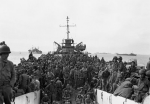
1018156201 |
73k |
Namesake
Inchon - Inchon Korean War, 1950. The United States Eighth Army and the South Korean forces, all under Gen. Walton Walker, finally checked the Communist conquest of
the Korean peninsula at the Pusan Perimeter, in the southeast, in August 1950. Meanwhile, the United Nations supreme commander, Gen. Douglas MacArthur,
prepared to strike at the right rear of the invading North Korean army. On September 15 the newly organized X Corps (1st Marine and 7th Infantry divisions) under
Gen. Edward Almond made an amphibious landing at Inchon, near the port of the South Korean capital of Seoul on the west coast. Preceded by two days of naval
bombardment, the 1st Alanne Division of Gen. Oliver Smith seized the tiny offshore island of Moontip (Wolmi-do) in the morning and then stormed the beaches later
that day. Forcing their way inland against surprisingly weak North Korean resistance, the marines captured Kimpo Airfield to the north on September 17, the same
day the 7th Infantry began coming ashore. Seoul came under attack as the American X Corps deepened and widened its beachhead. At the same time (September) the
Eighth Army, now 40,000 strong, broke out of the Pusan Perimeter and headed northwest toward Seoul. The thinly stretched North Korean lines began to crumble.
On September 26 the two American forces linked up near Osan, cutting off elements 42 of eight Communist divisions in the southwest. On the same day the battered city of
Seoul was liberated, except for isolated pockets of street fighting. Moving rapidly northward, American and South Korean forces reached the
vicinity of the 38th parallel on October t. The first ROK (Republic of Korea) unit crossed the troublesome boundary that day. Walker's troops, under the authorization
of the United Nations, did so eight days later. See Pusan Perimeter; North Korea; Korean War.
Photo - Troops of the 31st Inf. Regt. land at Inchon Harbor, Korea, aboard LST's. September 18, 1950. Hunkins. US Army Signal Corps photo # 111-SC-363215 NARA War and Conflict Book # 1383
Map -The landing at Inchon - US Marine Operations in Korea, Vol II2 (Wikipedia)
| Tommy Trampp |

